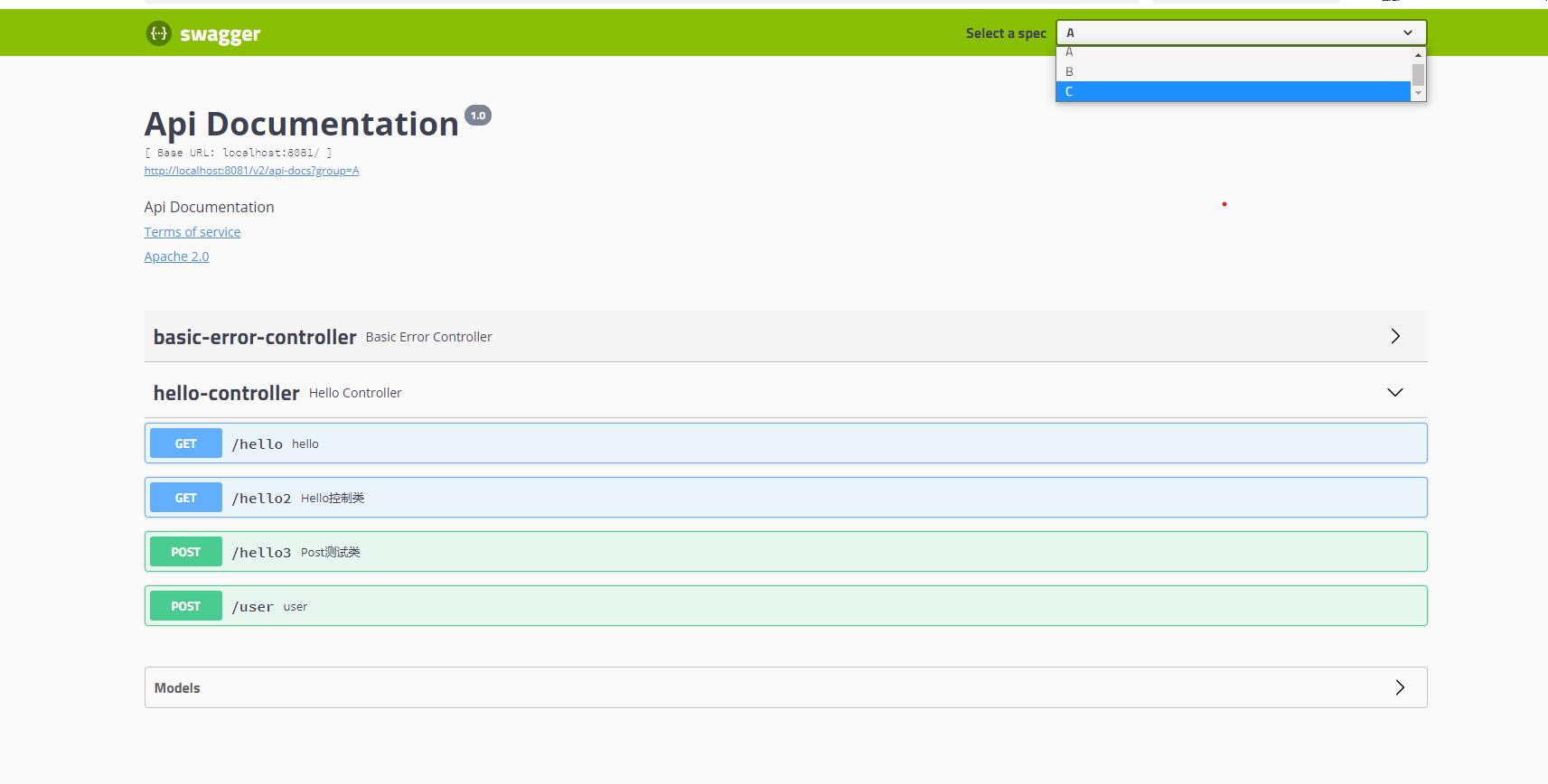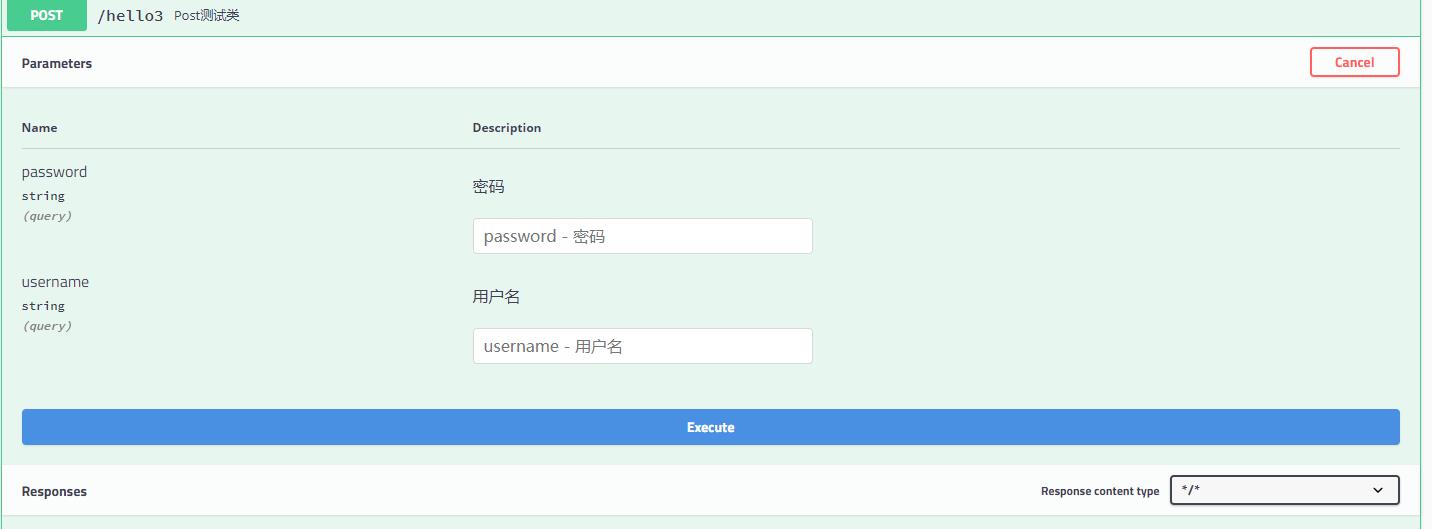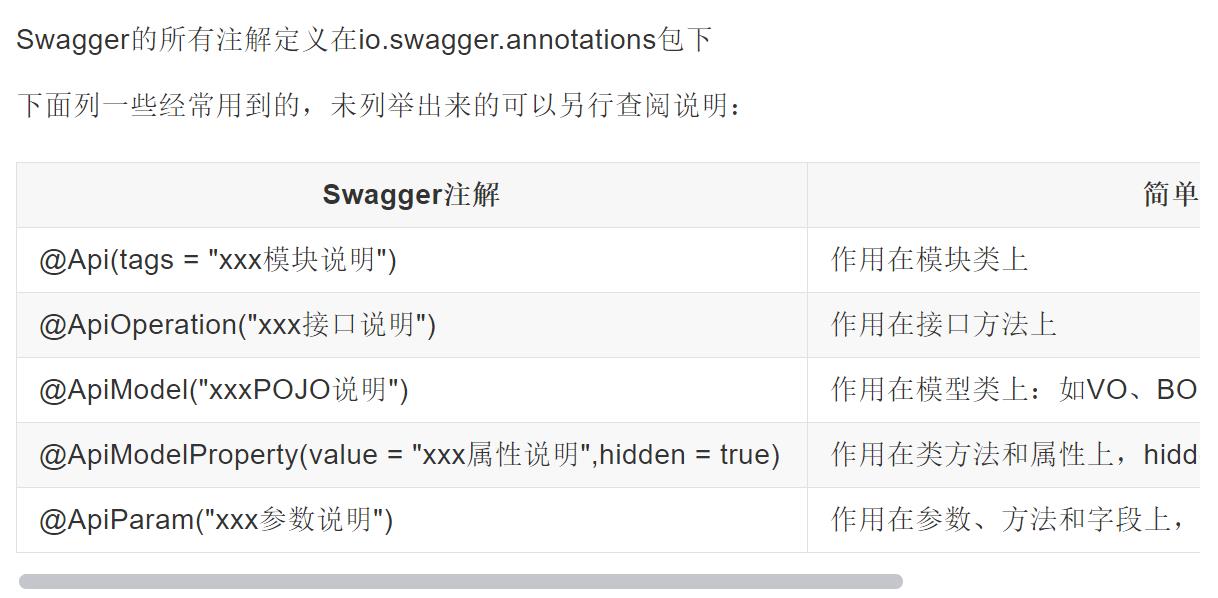springBoot简单使用Swagger
Posted 冷血~多好
tags:
篇首语:本文由小常识网(cha138.com)小编为大家整理,主要介绍了springBoot简单使用Swagger相关的知识,希望对你有一定的参考价值。
导语:
相信无论是前端还是后端开发,都或多或少地被接口文档折磨过。前端经常抱怨后端给的接口文档与实际情况不一致。后端又觉得编写及维护接口文档会耗费不少精力,经常来不及更新。其实无论是前端调用后端,还是后端调用后端,都期望有一个好的接口文档。但是这个接口文档对于程序员来说,就跟注释一样,经常会抱怨别人写的代码没有写注释,然而自己写起代码起来,最讨厌的,也是写注释。所以仅仅只通过强制来规范大家是不够的,随着时间推移,版本迭代,接口文档往往很容易就跟不上代码了。
发现了痛点就要去找解决方案。解决方案用的人多了,就成了标准的规范,这就是Swagger的由来。通过这套规范,你只需要按照它的规范去定义接口及接口相关的信息。再通过Swagger衍生出来的一系列项目和工具,就可以做到生成各种格式的接口文档,生成多种语言的客户端和服务端的代码,以及在线接口调试页面等等。这样,如果按照新的开发模式,在开发新版本或者迭代版本的时候,只需要更新Swagger描述文件,就可以自动生成接口文档和客户端服务端代码,做到调用端代码、服务端代码以及接口文档的一致性。
Swagger
-
号称世界上最流行的API框架
-
Restful Api 文档在线自动生成器 => API 文档 与API 定义同步更新
-
直接运行,在线测试API
-
支持多种语言 (如:Java,php等)
-
官网:https://swagger.io/
开始使用

导入依赖
<!-- https://mvnrepository.com/artifact/io.springfox/springfox-swagger2 -->
<dependency>
<groupId>io.springfox</groupId>
<artifactId>springfox-swagger2</artifactId>
<version>2.9.2</version>
</dependency>
<!-- https://mvnrepository.com/artifact/io.springfox/springfox-swagger-ui -->
<dependency>
<groupId>io.springfox</groupId>
<artifactId>springfox-swagger-ui</artifactId>
<version>2.9.2</version>
</dependency>使用Swagger,我们需要编写一个配置类-SwaggerConfig来配置 Swagger
编写SwaggerConfigl类
package com.chen.config;
import jdk.nashorn.internal.ir.RuntimeNode;
import org.springframework.context.annotation.Bean;
import org.springframework.context.annotation.Configuration;
import org.springframework.context.annotation.Profile;
import org.springframework.core.env.Environment;
import org.springframework.core.env.Profiles;
import org.springframework.web.bind.annotation.GetMapping;
import org.springframework.web.bind.annotation.RestController;
import springfox.documentation.builders.PathSelectors;
import springfox.documentation.builders.RequestHandlerSelectors;
import springfox.documentation.service.ApiInfo;
import springfox.documentation.service.Contact;
import springfox.documentation.spi.DocumentationType;
import springfox.documentation.spring.web.plugins.Docket;
import springfox.documentation.swagger2.annotations.EnableSwagger2;
import sun.plugin.dom.core.Document;
import java.lang.reflect.Array;
import java.util.ArrayList;
@Configuration
@EnableSwagger2 //开启Swaqger2
public class SwaggerConfig {
//groupName()->配置多个分组
@Bean
public Docket docket1(){
return new Docket(DocumentationType.SWAGGER_2).groupName("A");
}
@Bean
public Docket docket2(){
return new Docket(DocumentationType.SWAGGER_2).groupName("B");
}
//配置了swagger的Docket的bean实例
//访问路径:http://localhost:8080/swagger-ui.html#/
@Bean
public Docket docket(Environment environment) {
//设置要显示的开发者环境
Profiles profiles= Profiles.of("dev","test");
//获取项目的环境:
boolean flag= environment.acceptsProfiles(profiles);
System.out.println("==="+flag);
return new Docket(DocumentationType.SWAGGER_2)
.apiInfo(apiInfo())
.groupName("C")
.enable(flag) //enable是否启动swagger,如果为false,则swagger不能再浏览器中访问
.select()
//RequestHandlerSelectors配置要扫描的接口
//basePackage:指定要扫描的包
//any():扫描全部
//none:不扫描
.apis(RequestHandlerSelectors.basePackage("com.chen.controller"))
//withClassAnnotation()扫描类上的注解,参数是一个注解的反射对象
//withMethodAnnotation()扫描方法上的注解
//.apis(RequestHandlerSelectors.withClassAnnotation(RestController.class))
//paths() 过滤什么路径
//.paths(PathSelectors.ant("/chen/**"))
.build();
}
//配置Swagger信息==apiInfo
private ApiInfo apiInfo(){
//作者信息
Contact contact=new Contact("陈锦贤","url","129@qq.com");
return new ApiInfo("test Swagger文档",
"Api Documentation",
"1.0",
"urn:tos",
contact,
"Apache 2.0" ,
"url",
new ArrayList());
}
}
编写实体类: User
package com.chen.pojo;
import io.swagger.annotations.ApiModel;
import io.swagger.annotations.ApiModelProperty;
//Api(注释)
@ApiModel("用户实体类")
public class User {
@ApiModelProperty("用户名")
public String username;
@ApiModelProperty("密码")
public String password;
public String getUsername() {
return username;
}
public void setUsername(String username) {
this.username = username;
}
public String getPassword() {
return password;
}
public void setPassword(String password) {
this.password = password;
}
}
编写控制类:HelloController
package com.chen.controller;
import com.chen.pojo.User;
import io.swagger.annotations.ApiOperation;
import io.swagger.annotations.ApiParam;
import org.springframework.web.bind.annotation.GetMapping;
import org.springframework.web.bind.annotation.PostMapping;
import org.springframework.web.bind.annotation.RequestMapping;
import org.springframework.web.bind.annotation.RestController;
@RestController
public class HelloController {
@GetMapping("/hello")
public String hello(){
return "hello";
}
//只有我们的接口中,返回值中存在实体类
@PostMapping("/user")
public User user(){
return new User();
}
//operation接口,不是放在实体类上,是方法
@ApiOperation("Hello控制类")
@GetMapping("/hello2")
public String hello(@ApiParam("用户名") String username){
return "hello2"+username;
}
//operation接口,不是放在实体类上,是方法
@ApiOperation("Post测试类")
@PostMapping("/hello3")
public User hello3(@ApiParam("用户名") User user){
return user;
}
}
进行测试:
浏览器打开: http://localhost:8081/swagger-ui.html

点击try it out 进行测试


最后我们可以导入不同的包实现不同的皮肤定义:
<!-- 引入swagger-bootstrap-ui包 /doc.html-->
<!-- <dependency>
<groupId>com.github.xiaoymin</groupId>
<artifactId>swagger-bootstrap-ui</artifactId>
<version>1.9.1</version>
</dependency>-->
<!-- 引入swagger-ui-layer包 /docs.html-->
<!-- <dependency>
<groupId>com.github.caspar-chen</groupId>
<artifactId>swagger-ui-layer</artifactId>
<version>1.1.3</version>
</dependency>-->
<!-- 引入swagger-ui-layer包 /document.html-->
<!-- <dependency>
<groupId>com.zyplayer</groupId>
<artifactId>swagger-mg-ui</artifactId>
<version>1.0.6</version>
</dependency>-->
笔记出处:https://www.bilibili.com/video/BV1PE411i7CV?p=48
以上是关于springBoot简单使用Swagger的主要内容,如果未能解决你的问题,请参考以下文章
